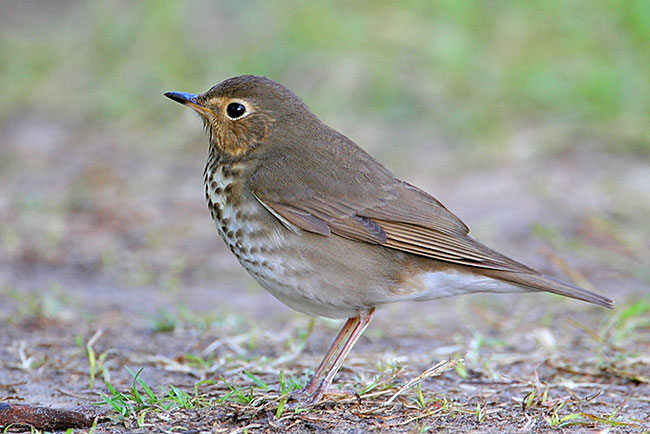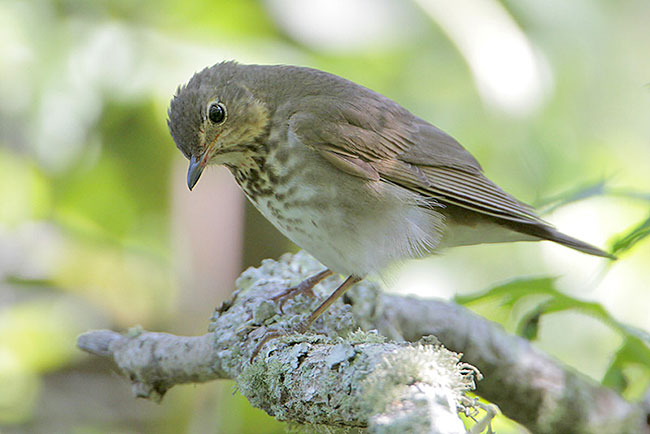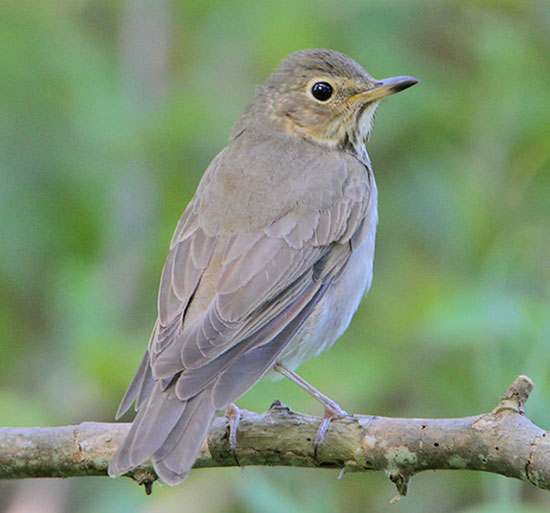The Swainson’s Thrush is a species of thrush found in woods with dense undergrowth across Alaska, Canada, Mexico, South America, and the northern United States. They can also be found in the wooded areas on North America’s Pacific coast. These are slim songbirds but medium-sized thrushes. They have short, straight bills and round heads. Their wings are reasonably long, and the medium-length tail makes the backside look long.


Identification
It’s hard to identify male and female when it comes to the Swainson’s Thrush because they look very similar. These birds have spotted chests and pale underparts. One interesting feature is the large eyerings that extend down to the front of the eye. It almost looks like they have glasses. Their throats are whitish and are surrounded by a dark brown stripe.
Swainson’s Thrushes do have regional differences. Swainson’s Thrushes that breed in the Pacific states are usually called the “Russet-backed” Thrush. This is because of the rusty-brown color, lighter brown chest spotting, and paler, thinner eyerings. The widespread eastern and northern Swainson’s Thrush that breeds in Nevada is usually called the “Olive-backed Thrush.”

Food
Swainson’s Thrushes diet primarily consists of insects and berries.
During breeding season, they mostly eat arthropods and insects. In the fall and winter, they eat fruits. Interestingly, these birds are known to favor red fruits and reject yellow ones. Some of the fruit Swainson’s Thrushes can be found eating are blackberries, elderberries, raspberries, huckleberries, twinberries, and other fruits that can be found in the wild. Insects these birds commonly consume include caterpillars, beetles, flies, and grasshoppers.
Swainson’s Thrushes also feed on ants; this is a little out of the ordinary because a diet that includes ants is usually associated with birds like woodpeckers. It’s unusual for temperate songbirds to consume this insect. Additionally, nestlings are fed mostly insects, including beetles, flies, moths, and caterpillars.
Nesting and Eggs
Swainson’s Thrushes build their nests on trees such as fir, willow, blackberry, spruce, alder, birch, aspen, maple, briers, oak, rose, gooseberry, and sumac. The nest is almost always placed in a shady area, usually three to ten feet off the ground.
The nest is an open cup, compact nest. It’s one and a half to four inches tall, has an outside diameter of three and a half to six inches, an inside diameter of two to three inches, and has a depth of one to two and a half inches. Swainson’s Thrushes make their nests out of stems, fine twigs, grass, bark shreds, moss, and decayed leaves. The inside of the nest is lined with rootlets, skeletonized leaves, moss, or lichens. The female Swainson’s Thrush will build the nest on her own. It usually takes around four days to complete. A new nest will be created each season.
- Clutch size can be anywhere from one to five eggs.
- The length of the eggs is 0.8 to 1 inch or 2 – 2.6 centimeters.
- The width of the eggs is 0.6 – 0.7 inches or 1.5 – 1.8 centimeters.
- Eggs are blue to greenish in color; they also have reddish or brown speckles.
Current Situation
It is estimated that the global breeding population of Swainson’s Thrushes is one hundred and twenty million. This thrush species has a short breeding season, which means they’re more sensitive than other birds to any disturbances on their nesting grounds. Some disturbances may include development, grazing, invasive plants, and human activity.
During the fall and spring migration, a notable number of Swainson’s Thrushes die from collisions with radio towers, windows, cell phone towers, and tall buildings. As a result, Swainson’s Thrush populations appear to be declining; however, they’re a widespread breeding bird that occupies much of North America. It’s important to note that they are still vulnerable to habitat loss on their wintering and breeding grounds.
Facts
- Swainson’s Thrushes have the nickname “mosquito thrushes.” This is because of their flycatching ability. It’s not uncommon to see them going after flying insects when they’ve made it to their breeding grounds.
- The Swainson’s Thrush was named after William Swainson, a 17th-century self-taught British naturalist. Swainson was a passionate taxidermist, skilled illustrator of birds, and solo collector.
- The Pacific population of Swainson’s Thrushes, also known as “russet-backed,” has plumage that is more reddish. They also have a slightly different song than the Swainson’s Thrushes that nest elsewhere, also known as “olive-backed.” The russet-backed thrushes winter in Central America, while the olive-backed thrushes winter in South America.
- Males settle their territorial disputes with singing duels. Frequency and volume will escalate until the dueler’s exertions are evident. During these duels, rivals sometimes invert their normal melody so that it goes down in pitch as the song continues. If the sing-off were not enough, a chase or even a physical attack would ensue.
Similar Species
The Swainson’s Thrush has features that are similar to other bird species. Here are some similar species:
- Hermit Thrush – Hermit Thrushes have more striking cinnamon-colored tails and whitish eyerings. Swainson’s Thrushes have tails that are browner in color and buffy eyerings.
- Veery – Veery have a much less obvious spotting on the chest compared to Swainson’s Thrushes. They also have fainter eyerings and are much warmer in color.
- Bicknell’s Thrush – Bicknell’s Thrushes have grayish eyerings and grayer faces. Swainson’s Thrushes have buffy eyerings and tanner faces.
- Gray-cheeked Thrush – Gray-cheeked Thrushes have thinner grayish earrings and grayer faces compared to Swainson’s Thrushes. Swainson’s Thrushes have buffy eyerings and tanner faces.
- Wood Thrush – Wood Thrushes are plumper and larger than Swainson’s Thrushes. They also have white underparts with dark round spots and very prominent white earrings. Swainson’s Thrushes have buffy eyerings and blurry spots on a tan-colored chest.
FAQ
Where do Swainson’s Thrush live?
The Swainson’s Thrush lives in woods with dense undergrowth across Alaska, Canada, Mexico, South America, and the northern United States.
Where does Swainson’s Thrush winter?
Swainson’s Thrushes winter in Central and South America in the forest-pasture edges and mature tropical forests.
Is Swainson’s Thrush rare?
No, Swainson’s Thrushes are not rare. There is a large population, and during peak migration, they can commonly be seen in parks and woodlots.
What is the sound of a Swainson’s Thrush?
Swainson’s Thrushes have a single-note, high-pitched whine similar to the American Robin. They also make a bink-like sound which can be compared to water dropping onto a hard surface.
Is Swainson’s Thrush endangered?
The Swainson’s Thrush is not endangered. They have a conservation status of least concern. However, their population is declining.


